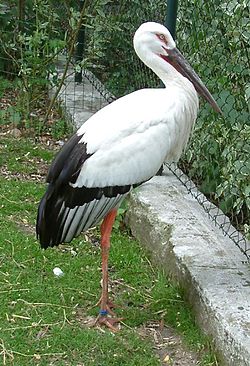鸛
| ||||||||
Translingual
| Traditional | 鸛 |
|---|---|
| Shinjitai (extended) |
⿰𮥶鳥 |
| Simplified | 鹳 |
Han character
鸛 (Kangxi radical 196, 鳥+18, 29 strokes, cangjie input 廿土竹日火 (TGHAF), four-corner 47227, composition ⿰雚鳥)
References
- Kangxi Dictionary: page 1504, character 39
- Dai Kanwa Jiten: character 47500
- Dae Jaweon: page 2034, character 11
- Hanyu Da Zidian (first edition): volume 7, page 4670, character 22
- Unihan data for U+9E1B
Chinese
| trad. | 鸛 | |
|---|---|---|
| simp. | 鹳 | |
| alternative forms | 雚 | |
Glyph origin
Phono-semantic compound (形聲 / 形声, OC *koːns) : phonetic 雚 (OC *koːns, “stork”) + semantic 鳥 (“bird”). Originally written 雚.
Pronunciation
- Mandarin
- Cantonese (Jyutping): gun3
- Puxian Min (Pouseng Ping'ing): guang4 / guong4
- Southern Min (Hokkien, POJ): koàn
- Mandarin
- (Standard Chinese)+
- Hanyu Pinyin:
- Zhuyin: ㄍㄨㄢˋ
- Tongyong Pinyin: guàn
- Wade–Giles: kuan4
- Yale: gwàn
- Gwoyeu Romatzyh: guann
- Palladius: гуань (guanʹ)
- Sinological IPA (key): /ku̯än⁵¹/
- (Standard Chinese)+
- Cantonese
- (Standard Cantonese, Guangzhou–Hong Kong)
- Jyutping: gun3
- Yale: gun
- Cantonese Pinyin: gun3
- Guangdong Romanization: gun3
- Sinological IPA (key): /kuːn³³/
- (Standard Cantonese, Guangzhou–Hong Kong)
- Puxian Min
- (Putian)
- Pouseng Ping'ing: guang4
- Sinological IPA (key): /kuaŋ⁴²/
- (Xianyou)
- Pouseng Ping'ing: guong4
- Sinological IPA (key): /kuoŋ⁴²/
- (Putian)
- Southern Min
- Middle Chinese: kwanH
- Old Chinese
- (Baxter–Sagart): /*C.qʷˤar-s/
- (Zhengzhang): /*koːns/
Definitions
鸛
- stork
- crane (Grus japonensis)
- Used in 鵝鸛/鹅鹳 (éguàn).
Synonyms
Compounds
References
- “鸛”, in 漢語多功能字庫 (Multi-function Chinese Character Database), 香港中文大學 (the Chinese University of Hong Kong), 2014–
- William Campbell (1913) A dictionary of the Amoy vernacular spoken throughout the prefectures of Chin-Chiu, Chiang-Chiu and Formosa (in Hokkien), 8th edition, Tainan: Taiwan Church Press, published 1961, →OCLC, page 351.
- 莆田市荔城区档案馆 , editor (2022), “鹳”, in 莆仙方言文读字汇 [Puxian Dialect Literary Reading Dictionary] (overall work in Mandarin and Puxian Min), page 81.
Japanese
| ⿰𮥶鳥 | |
| 鸛 |
Kanji
(Hyōgai kanji, kyūjitai kanji, shinjitai form ⿰𮥶鳥)
Readings
- Go-on: かん (kan)←くわん (kwan, historical)
- Kan-on: かん (kan)←くわん (kwan, historical)
- Kun: こうのとり (kōnotori, 鸛)←こふのとり (kofunotori, 鸛, historical)
Etymology 1
| Kanji in this term |
|---|
| 鸛 |
| こうのとり Hyōgai |
| kun'yomi |
Compound of 鸛 (kō, “Oriental stork”, see below) + の (no, attributive particle) + 鳥 (tori, “bird”).
Pronunciation
Noun
鸛 or 鸛 • (kōnotori) ←こふのとり (kofunotori) or コフノトリ (kofunotori)?
- Oriental stork (Ciconia boyciana)
- Synonym: 鸛鶴 (kōzuru)
- (by extension) any stork
Usage notes
As with many terms that name organisms, this term is often spelled in katakana, especially in biological contexts (where katakana is customary), as コウノトリ.
Etymology 2
| Kanji in this term |
|---|
| 鸛 |
| こう Hyōgai |
| kun'yomi |
/kan/ → /kau/ → /koː/
Pronunciation
Noun
鸛 or 鸛 • (kō) ←こふ (kofu) or コフ (kofu)?
As with many terms that name organisms, this term is often spelled in katakana, especially in biological contexts (where katakana is customary), as コウ.
Derived terms
- 鸛鶴 (kōzuru)
- 青嘴鸛 (aohashikō, “white-bellied stork (Ciconia abdimii)”)
- 朱嘴鸛 (akahashikō)
- 燕尾鸛 (enbikō, “maguari stork (Ciconia maguari)”)
- 鞍嘴鸛 (kurahashikō)
- 朱嘴鸛 (shubashikō, “white stork (Ciconia ciconia)”)
- 白襟鸛 (shiroerikō, “Asian woolly-necked stork (Ciconia episcopus)”)
- 朱鷺鸛 (tokikō)
- 鍋鸛 (nabekō, “black stork (Ciconia nigra)”)
- 禿鸛 (hagekō)
- 嘴広鸛 (hashibirokō, “shoebill (Balaeniceps rex)”)
References
Korean
Hanja
鸛 • (gwan) (hangeul 관, revised gwan, McCune–Reischauer kwan, Yale kwan)
- crane (Grus japonensis)
- stork (Ciconia species)
Vietnamese
Han character
- This term needs a translation to English. Please help out and add a translation, then remove the text
{{rfdef}}.

